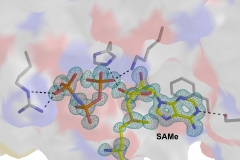
2016/02/09
Observation at atomic resolution of an enzyme opens a pathway for inhibition of colon and liver cancer.
A team of scientists from CIC bioGUNE, University of Liverpool and Cedars-Sinai hospital in California, using high-resolution structures, have determined the catalytic steps of the enzyme MATα2.
This study opens up a new pathway in the development of highly targeted drugs that act exclusively on this enzyme, regulating cancer cell growth.
The study has been published in the latest issue of Proceedings of the National Academy of Sciences USA (PNAS)
(Bilbao, February 9 2016). A study led by the Basque Center for Cooperative Research in Biosciences CIC bioGUNE, in collaboration with Liverpool University and Cedars-Sinai Hospital in California, has determined at atomic resolution the crystallographic structure of an enzyme related with the growth of colon and liver cancer cells. This study opens a new pathway in the design of molecules that can be used in the development of new drugs against these types of cancer.
This enzyme sensitizes SAMe, a molecule that plays a key role in the correct functioning of the cells. In normal cells, SAMe is produced by a homologue protein MATα1: however, in colon and liver cancer cells, this molecule is produced by MATα2. This switch of function alters the levels of SAMe in the cell, promoting the reproduction of cancer cells.
CIC bioGUNE researchers have for the first time obtained a group of crystallographic structures in which various stages of the enzymatic reaction MATα2 can be observed, thereby providing a detailed insight into the mechanism of catalytic action. This information will enable the future development of molecules that can be used to regulate the function of this enzyme.
The CIC bioGUNE researcher Adriana Rojas, one of the co-authors of this study published in the Proceedings of the National Academy of Sciences USA (PNAS), highlights the relevance of this result. "The fact that we can see the crystallographic structure at 1 angstrom resolution provides us with information of an extremely precise nature for the next step: the development of drugs designed to block or reduce the activity of this protein".
The research involved X-ray crystallography and the use of European particle accelerators with beam lines dedicated to study proteins (ALBA in Barcelona (Spain) and DIAMOND in the UK). This work is part of the research line of José María Mato, General Director of CIC bioGUNE, and his team, who have dedicated more than 30 years of research to the field of liver cancer.
About CIC bioGUNE
The Center for Cooperative Research in Biosciences (CIC bioGUNE), set up by the Basque Government Department of Industry in 2002 and located in the Bizkaia Technology Park, is a biomedical research organisation conducting cutting-edge research at the interface between structural, molecular and cell biology, with a particular focus on the study of the molecular bases of liver cancer, for use in the development of new diagnostic methods and advanced therapies.
See a large version of the first picture





